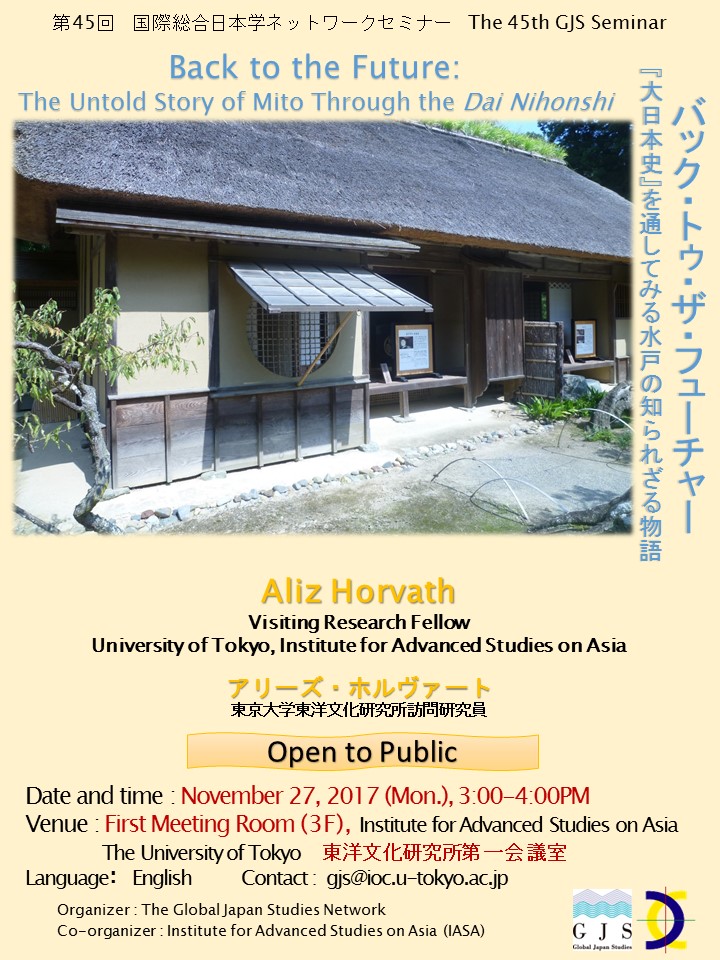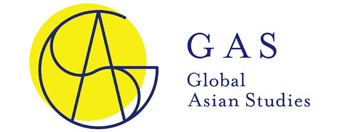The 45th GJS SeminarBack to the Future: The Untold Story of Mito Through the Dai Nihonshi
| Date and time: | November 27, 2017 (Mon.), 3:00-4:00PM |
|---|---|
| Venue: | First Meeting Room (3F), Institute for Advanced Studies on Asia, The University of Tokyo |
| Speaker: | Aliz Horvath (Visiting Research Fellow, University of Tokyo, Institute for Advanced Studies on Asia) |
| Language: | English |

Abstract: Controversial – this is the notion that perhaps describes the intellectual history of Mito most accurately. Contradictions can be detected in almost every relevant concept: for example, how did a domain initially open to foreign influences in the 17th century ended up becoming associated with xenophobia due to the idea of sonnō jōi (尊皇攘夷 “revere the emperor, expel the barbarians”) at the end of the Tokugawa period? How are we to understand their initially emperor-focused attitude in history writing while belonging to the gosanke (御三家, the three domains privileged by the shogun’s government). Why and how was the most monumental history writing project in Japan, the Dai Nihonshi (大日本史, The History of Great Japan), the compilation of which covered 250 years, produced at a relatively unlikely place, in Mito, instead of a major intellectual hub, such as Edo or Kyoto? Or, on a less abstract level, how did the founder of the Shōkōkan (彰考館, the historiographical institute of Mito, their center of scholarly inquiry), Tokugawa Mitsukuni (徳川光圀), the second daimyo of the Mito domain, end up becoming well-known as the protagonist of an extraordinarily popular television series, the legendary Mito Kōmon? Most of these questions are yet to be fully explored, but they all have one thing in common: they all imply a process, change, shift, telling us the story of how the image of texts, people, and places can transform into something that can make the original version barely recognizable. My presentation intends to focus on tracing these important points and changes as determining factors in the understanding of this unique segment of Tokugawa intellectual history.
The very limited Western scholarship focuses predominantly on Mito’s later period in the 19th century and their role in the Meiji restoration, analyzing their association with xenophobic tendencies. The significantly more abundant Japanese existing literature, on the other hand, covers both the earlier and the later periods, but, for the most part, does not devote particular attention to the actual analysis of the Dai Nihonshi and concentrates instead on the other scholarly productions of the Shōkōkan – despite the text’s role as the most longstanding and fundamental purpose for the existence of the institution. Through the analysis of the structural and stylistic characteristics of the Dai Nihonshi and a variety of other sources produced by its authors, the talk will present a novel approach to the understanding of the role of this work and its influence on Mito in general with a special focus on its compilation process - based on the qualitative study of primary materials and the quantitative data of more than 150 compilers. This session of the seminar series invites the audience to think together and discuss the potential of such approaches, the significance of Mito, and, in a broader sense, the question of monumentality and the shifting meaning of history, truth, and facts in the context of Tokugawa intellectual life. Organizer: The Global Japan Studies Network (GJS)Co-organizer: Institute for Advanced Studeis on Asia (IASA)
Contact: gjs[at]ioc.u-tokyo.ac.jp



